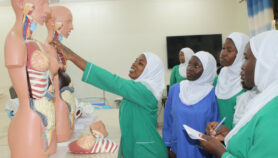By: Manoj Patairiya
Send to a friend
The details you provide on this page will not be used to send unsolicited email, and will not be sold to a 3rd party. See privacy policy.
Introduction
For the past two decades or so, science communication activities have gained momentum in India. Efforts have been made from both governmental and non-governmental platforms to enhance the public understanding of science. The idea is to help science and a scientific culture penetrate India’s socio-culturally diverse society, and to transform it into a nation of scientifically thinking and scientifically aware people.
The historical context
India has an impressive scientific heritage. Scientific research — in fields such as mathematics, astronomy, medicine and material science — has been carried out in the Indian sub-continent since ancient times. However, a remarkable gap has persisted between this scientific knowledge and the ‘common’ man and woman and, until recently, almost no effort has been made to bridge this gap.
Throughout history, there have been attempts to take science to the common people. For example, Vigyan (Science) — a monthly popular science magazine in Hindi — has been published by Vigyan Parishad (a learned society of scientists and academics) since 1915.
Following Independence in 1947, the first Prime Minister of India, Pandit Jawaharlal Nehru, introduced the concept of modern ‘scientific temper’ — a phrase taken to mean an enquiring attitude and analytical approach that leads to rational thinking and the pursuit of truth without prejudice. Accordingly, the constitution of India has a special provision “to develop the scientific temper, humanism and spirit of enquiry”.
The science communication movement in India
After Independence, a number of government agencies and non-governmental organisations (NGOs) took their cue from the constitution and became involved in science popularisation. In this way, science communication was taken up at various levels, institutional as well as individual. Nehru was a major force behind this advancement of science in independent India.
The National Institute of Science Communication (NISCOM) — previously the Publications and Information Directorate — began publishing of the Hindi popular science journal Vigyan Pragati (Progress in Science) in 1952. The Science Reporter (an English monthly) and Science Ki Dunia (an Urdu quarterly) followed soon after. Today, NISCOM also brings out 11 professional scientific journals and publishes various popular science books (often in Indian languages).
In 1980, science communication was given prominence in India’s sixth Five Year Plan, and two years later the National Council for Science and Technology Communication (NCSTC) was established. The Council has a mandate to integrate, coordinate, catalyse and support science communication and popularisation, at the micro as well as macro level. NCSTC’s programmes include training in science and technology communication, software development, research, field-based projects, and creating information networks and databases.
Other Indian government initiatives include Vigyan Prasar — an autonomous organisation of the Department of Science and Technology set up in 1989 — which plays an important role in coordinating efforts among various scientific institutions, educational and academic bodies, laboratories, museums, industry and other organisations for the effective exchange and dissemination of scientific information. Vigyan Prasar also develops and disseminates software materials and organises popular science events including workshops, debates and lectures.
The National Council of Science Museums, based in Calcutta, is the coordinating body of 26 science museums and science centres across the country. Science City in Calcutta has more than 1,000 exhibits and attracts around 500,000 visitors a year. Based on the experiences and popularity of Science City, other such projects are being developed across the country.
Several NGOs have also pursued science communication programmes. The Indian Science Writers’ Association (ISWA), for example, was founded in 1985 with a view to developing and nurturing the science writing profession in India. The association has around 200 members and undertakes a broad spectrum of activities including training courses, lectures and fellowships. ISWA also works with government agencies and NGOs in promoting science communication activities.
A diversity of science communication media
India’s science communicators have used various modes of communication to reach out to the masses. As a result, a lot of infrastructure, software and human resources are available in the country. Each has its own significance and utility, given the vast diversities that exist in the country.
Print media
In addition to the scientific journals (both popular and technical) published by the government, several national and regional daily newspapers have now started producing weekly science pages. In a unique initiative, Vigyan Prasar provides a weekly ready-to-print science page, in both Hindi and English, which some 21 newspapers use at a nominal cost.
Sadly, however, there are signs that interest in science communication is waning in the print media. For example, the Indian science magazines Science Today and Bulletin of Sciences have been discontinued, as have Indian editions of certain foreign magazines, such as La Recherche and Scientific American.
Audio-visual media
A variety of science-based programmes are now available on All India Radio (AIR), such as Radioscope, Science Today, Science Magazine and Science News. In the early 1990s a landmark 144-part radio serial Manav Ka Vikas (Human Evolution) was jointly produced by NCSTC and AIR. The programme was broadcast simultaneously from more than 80 radio stations in 18 Indian languages with 100,000 children and 10,000 schools registered as dedicated listeners.
A number of television channels have also been broadcasting science programmes for many years. For example, a 13-part film serial on the history of science and technology in the Indian sub-continent and its impact on the world, entitled Bharat Ki Chhaap, was produced by NCSTC and broadcast on the state-run Doordarshan channel in 1989.
Folk media
It is a common observation that folk media — such as puppet shows, street plays, stage performances, and folk songs and dances — successfully reach segments of society where other forms of media have limitations. These traditional means of communication have all been exploited as alternative media for science communication. They are not only entertaining, but also offer two-way communication and are cost effective.
Several voluntary agencies, such as Kerala’s Shastra Sahitya Parishad (People’s Science Movement), are actively involved in taking science to the people, especially through folk forms. Where print and electronic media have limits rooted in literacy levels and accessibility, folk media can play a crucial role.
‘Interactive’ media
Science exhibitions, science fairs, demonstrations, seminars, workshops, lectures, scientific tours, conferences and, more recently, digital software, have the advantage of being interactive forms of science communication.
Perhaps the most impressive example is the Vigyan Jatha. During this massive event, science communicators march in groups from village to village, interacting with local people and spreading information about science relevant to their day-to-day lives. Catalysed by NCSTC, Vigyan Jatha could be considered the biggest science communication experiment anywhere in the world. Held in 1987 and 1992, themes have included health, water, environment, appropriate technology, superstitions, scientific thinking and literacy. Some 2,500 government agencies and NGOs have been actively involved, and the Jatha have covered nearly 40,000 locations in about 400 districts, touching almost a third of the country’s population.
The annual Children’s Science Congress — started in 1993 by the NCSTC Network — has become a highlight in the science communication calendar. The congress aims to extend classroom science teaching by providing 10- to 17-year-olds with an open ‘laboratory’ for enjoyable hands-on learning.
Another very popular and important programme in India has been the ‘scientific explanation of miracles’. This programme uses trained science ‘activists’ to demonstrate and explain so-called miracles. In 1995, for example, the author investigated and demonstrated the phenomenon of deities drinking milk on television, and exposed it as a hoax.
Most recently, information technology has given birth to a comparatively new form of interactive science communication — digital media — which includes the Internet and CD-ROMs. This is proving to be an effective way to illustrate difficult scientific concepts. It has also made science communication more accessible both to handicapped and less educated people. Though the reach of the technology is still a limiting factor, the government is working to extend this and reduce the costs of connectivity.
Present challenges and visions for the future
Although much has been achieved in India, there is still an urgent need to make science communication activities more effective, both in terms of quality and quantity. We have yet to make a dent in wiping out superstitions that have prevailed throughout the ages, particularly in tribal areas where literacy levels are low and superstition is a way of life. Also, the general public is still largely ignorant about common scientific principles, such as the fact that the Earth orbits the Sun.
Mass media
Science is not succeeding in attracting mass media interest. It rarely appears as a lead story, as editors and reporters do not consider science to be ‘news’ in the normal sense. On average, science only accounts for around three per cent of coverage by India’s mass media. Additionally, readership of popular science magazines has declined — people no longer rely on print material as their only source of information.
For this reason, the Indian Science Writers’ Association aims to encourage the editors of newspapers and magazines to regularly feature a science column. It also hopes to increase the readership of popular science magazines, for example by making them available through digital media. In addition, publications must cater to India’s many languages.
It is encouraging that radio, which is extremely popular in rural areas, has an increasing amount of scientific content. Television is following a similar pattern, with a few special channels on science and technology, and other channels featuring scientific discussions and interviews of scientists about their research. But it hasn’t yet reached a satisfactory level as far as science communication is concerned.
Mass education
There is no doubt that scientific information is becoming an essential and integral part of people’s daily lives. Present and future science communication efforts have great potential in shaping the lives of the people and making their decisions more informative and rational.
However, illiteracy and ignorance are major challenges. While literacy levels are increasing (currently estimated at 52 per cent of the population), scientific literacy is still drastically low. Given India’s large population, limited resources and multitude of languages, mass science education faces particularly great challenges. There have been efforts to popularise science through our 18 regional languages, for example by producing some scientific publications in vernaculars and translating certain television and radio programmes. But without more attention on local languages, much of the population will miss out on science communication efforts.
In an ideal world science communication activities would be widespread right down to the village level. In order to create awareness among illiterates or the newly literate — and to maintain the knowledge they acquire — folk forms must be used more frequently. In this way, superstitious beliefs could be wiped from society and a scientific environment created even at the grassroots level.
Training science communicators
Science writing still tends to be dry and boring, making it unsurprising that few science articles interest newspapers and magazines. The number of capable science communicators and voluntary scientific organisations is alarmingly low and hardly sufficient to cater to the country’s large and diverse population.
That said, a number of science communicators are being trained through postgraduate degree and diploma courses in science communication, and short-term science writing and journalism workshops. Indeed, four Indian science communicators have won UNESCO’s Kalinga Prize for their outstanding contributions to science communication and popularisation.
The way that scientific information is presented in the media needs to undergo a metamorphosis, with a new generation of the science writers and journalists presenting useful science in an interesting and innovative manner. For example, a science and technology news and features pool could be formed to allow writers and journalists to exchange information on scientific research and developments.
Networking
Most importantly, science communication activities must be conducted and governed in a systematically planned manner, under one umbrella organisation, and according to a properly defined national policy.
To an extent this issue is already being addressed. An All India People’s Science Network was created in the late 1980s, with 27 constituent voluntary organisations. The NCSTC Network started in 1991 with the objective of taking science popularisation activities to all the corners of the country. Presently it has around 100 members, including NGOs and government organisations. NCSTC has also started a countrywide project to compile information on science communication software, hardware, ‘humanware’ and agencies to facilitate further networking.
But the formation of networks of organisations alone is not sufficient. A suitable mechanism must be evolved to ensure we work together in a more cohesive manner.
I would also argue that we need a formal Science Media Network. In fact, moves have already been made towards a national database of science editors, writers, journalists, columnists, translators, ‘scientoonists’, illustrators, media-persons, producers, and media organisations interested in science coverage.
Conclusion
Following the industrial revolution in western countries, the level of science communication activities increased dramatically. In some ways, India is presently passing through a similar stage. As technology advances, the need for scientific information will also increase. Accordingly, an industrial India should soon witness a similar increase in science communication and popularisation. Indeed, the success of the information technology industry is proof of a growing scientific awareness in India.
India has undertaken a large number of science communication initiatives, and has sometimes led the way in innovative approaches. However, we should also be open to new ideas, methodologies and programmes available in other parts of the world, and similarly share with others the successful strategies we have employed.
As far as science writing and journalism are concerned, there is ample scope for furthering such efforts in developing countries. India could take the initiative in mobilising like-minded people in South Asia to form Science Writers’ and Journalists’ Associations in each country, ideally with help from international organisations.
The science communication scenario of our dreams is not unobtainable. Rather, it is based on technologies available today, which can be better utilised to carry scientific messages to the people. I believe that science communication in India has a bright future.
This article is based on a paper given by the author at the British Association for the Advancement of Science Festival held in Glasgow in September 2001.
The author is a scientist at India’s National Council for Science & Technology Communication and the honorary secretary of the Indian Science Writers’ Association based in New Delhi.
Email:
[email protected] or [email protected]
See also:
Vigyan Prasar
NCSM













